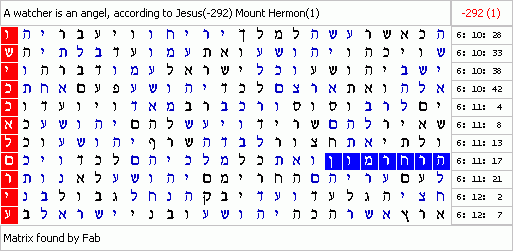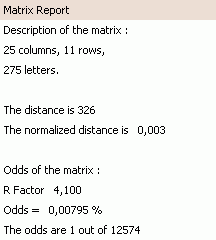
Code by Fab (6/Sept/2009)
A Watcher is an Angel; according to Jesus.



Following some discussion, I searched for and found a code in the Tanakh using the expression "a watcher is an angel". For "watcher", I used the spelling used in Daniel:
Daniel
4:13: "I saw in the visions of my head upon my bed, and, behold,
a watcher and an holy one came down from
heaven;"
Daniel 4:17: "This matter is by the decree of the watchers,
and the demand by the word of the holy ones: to the intent that
the living may know that the most High ruleth in the kingdom of men,
and giveth it to whomsoever he will, and setteth up over it the basest
of men."
Daniel 4:23: "And whereas the king saw a watcher and an holy
one coming down from heaven, and saying, Hew the tree down, and
destroy it; yet leave the stump of the roots thereof in the earth, even
with a band of iron and brass, in the tender grass of the field; and
let it be wet with the dew of heaven, and let his portion be with the
beasts of the field, till seven times pass over him;"
There were 1096 occurrences expected statistically, and 1131 were actually found. The minimal skip could be extended to "a watcher is an angel, according to Jesus" (the expression "according to Jesus" could be rendered "as/like Jesus", but I thought it didn't make sense since Jesus is not an angel, He was begotten and not created like the angels, cf Ezekiel 28:13, 15, Psalms 2:7, Acts 13:33, Hebrews 1:5, 5:5).
I also
noticed the expression "a watcher is an angel", in the code,
goes through this verse (relevant portion in bold, see further below
why):
Joshua 11:17: "from the bare mountain, that goeth up to Seir,
even unto Baal-gad in the valley of Lebanon under Mount Hermon;
and all their kings he took, and smote them, and put them to death."
Jesus shares a letter with "Joshua" in the surface text, and
Joshua is another way to spell His name in Hebrew (same meaning as Yeshua):
http://en.wikipedia.org/wiki/Joshua#Name
The English name Joshua is a rendering of the Hebrew: יהושע "Yehoshua," meaning "Hashem is Salvation," "Hashem delivers," or "Hashem rescues" from the Hebrew root ישע, "salvation," "to deliver/be liberated," or "to be victorious"[1] "salvation." It often lacks a Hebrew letter vav(ו) after the shin (ש), allowing a reading of the vocalization of the name as Yehoshea (יְהוֹשֵׁעַ) - the name is described in the Torah as having been originally Hoshea before being changed to Yehoshua by Moses (Numbers 13:16).
"Jesus" is the Anglicized transliteration of the Hellenized transliteration of "Yehoshua". In the Septuagint, all instances of "Yehoshua" are rendered as "ιησου" (Iesou/Jesus), the closest Greek pronunciation of the Hebrew.[2][3]
Several other things are interesting in this code, see below (highlighted in red):
http://en.wikipedia.org/wiki/Mount_Hermon#Biblical_history
Mount Hermon was called Senir by the Amorites and Sirion by the Sidonians (Deuteronomy 3:9 and see commentary of Rashi ad loc; Psalms 29:6; 1 Chronicles 5:23; Song 4:8; Ezekiel 27:5), names which may signify a "coat of mail" or "armor". The mountain served as the northern boundary of the Promised Land (Deuteronomy 3:8) and also was the northern limit of the conquest (Joshua 11:17, 12:1, 13:5).
The high places of Mount Hermon were used by the Canaanites in Canaanite mythological rituals. They referred to the mountain as Mount Ba'al-Hermon (Judges 3:3). It is also called Mount Sion or Mount Siyon (Deuteronomy 4:48).
The Gospels tell of Jesus and his disciples journeying north from Bethsaida on the Sea of Galilee to the city of Caesarea Philippi at the southern base of Mount Hermon (Matthew 16:13; Mark 8:27). There, Jesus revealed to them his purpose to build his Church and to go to Jerusalem to die and be resurrected (Matthew 16:18-21).
Mount Hermon was a possible site of the Transfiguration, where Jesus, according to the New Testament, supposedly took three of his disciples, Peter, James, and John, up on a high mountain for prayer. In the story, he became radiantly white and conversed with Mosesand Elijah, who had appeared beside him.
In the Book of Enoch, Mount Hermon is the place where the Grigori ("Watcher") class of fallen angels descended to Earth. They swore upon the mountain that they would take wives among the daughters of men and return (Enoch 6).